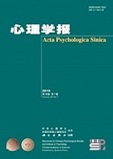|
|
The Encoding of Constituent Morphemes in the Oral Production of Chinese Disyllable Compound Words
CHEN Xu–Hai,HUANG Xi-Ting
2010, 42 (03):
377-386.
In the last twenty years, researchers of language production have been interested in the encoding of the morphologically simple and complex words. Studies in this area have focused on the processing of semantic, phonology and orthographic information, and on whether the morphological structure of words affects how the words are represented and accessed. In studies of Indo-European languages, there is accumulated evidence that the constituent morphemes have a salient priming effect in the oral production of compound words (Roelofs, A. 1996; Zwitserlood, 2002). However, there is no agreement concerning the role of the semantic, orthographic and phonological information in the processing, and the time course of this information processing (Damian, 2003; Dohmes, 2004; Meunier, F. & Longtin, C. M., 2007; Fornells, A. R., Schmitt, B. M., Kutas, M., & Müntea, T. F., 2002). Research on language comprehension in Chinese has also emphasized the importance of morphemes. This is particularly apparent in research using compound words, showing that semantic, phonological, and orthographic factors of morphemes, as well as the frequency of morphemes affect the access of the whole word (Zhou, et al., 1999. In the domain of language production, we only know of three studies that have explored the morphological encoding of mandarin Chinese. These studies have found that only the phonological information of the morphemes can promote the production of compound words, with not much influence from semantic and orthographic information (Chen T. M. & Chen J. Y., 2006, 2007; Chen, J. Y., Chen, T. M., & Dell, G. S. 2002). These three studies, however, used an implicit prime paradigm, yielding results that departed from studies of Indo-European language and of Chinese language comprehension. Other paradigms are thus needed for further verification of these findings. The present study investigated the activation - and its time course - of morphemes in Chinese disyllable compound words using a classical experimental method in language-production research: the picture-word interference paradigm. We hypothesized that morphemes can be encoded and that there would be facilitation both phonological and orthographical. We also hypothesized a semantic inhabitation in the oral production of compound words.
The present study includes three experiments. In the first one, we investigated the activation of morphemes in Chinese disyllable compound words with four kinds of "distractor" words (i.e., morphological, orthographic, phonological, and control) presented in different stimulus onset asynchrony SOA (i.e., -100ms, 0ms, 100ms) as participants (N = 39) named pictures. In Experiment Two we investigated the function of morpheme position in the Chinese disyllable compound words production and explored the role of semantic information. In this experiment (N = 42), we used the same design as in Experiment One but consider both morphemes of the words and changed the SOA (-200ms, 100ms). In Experiment Three (N = 18), we further investigated the semantic activation of morphemes in the Chinese disyllable compound words production. For this, we set a “semantic relative” prime to compare with the morphological prime.
The results of these experiments showed that the orthographic and phonological information of morphemes can facilitate the production of Chinese disyllable compound words. However, semantic information had no salient effects in either initial or second morpheme. Furthermore the orthographic effects came early than the phonological ones. The results of this study imply that the phonological and orthographic information of morphemes can facilitate the production of Chinese disyllable compound words but the semantic information may have a complex role. Moreover, there seems to be no morphological encoding in the oral production of Chinese disyllable compound words. The time course of morpheme activation in Chinese disyllable compound words is similar to the mono-syllable, with orthographic activation first (SOA=-200ms) followed by phonological activation (SOA= 100ms). The position of the morphemes had no salient effect in the production of Chinese disyllable compound words.
Related Articles |
Metrics
|




